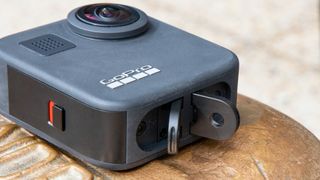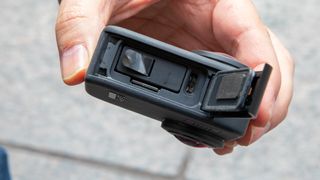Why you can trust TechRadar
Build & handling
- Compact design
- 5m water resistance
- 1,660mAh battery
- ‘Shotgun mic performance’
- True 360-degree audio
Apart from a couple of inherited features, like 5m water resistance and a generally rectangular shape, all of the Max’s physical properties are new. The most obvious of these is the inclusion of a vibrant 1.7-inch color touchscreen that is great for intuitive navigation, shot framing and checking recordings on the go.
The Max also gets the new foldable in-built mounting fingers that arrived on the Hero 8 Black, which makes it much easier to mount on a tripod or other action cam fixing systems. When you’re done filming, they tuck neatly away so the camera can stand up on a flat surface. This is critical for 360-cams like the Max, because they have lenses on both the front and rear, and have to stand on their edges in order to avoid scratches.

The GoPro Max manages to jettison more than 30% of the weight carried by the Fusion, making it just 28g heavier than the Hero 8 Black. This big transformation means the Max doesn’t need its own range of heavy-duty mounts and accessories like the Fusion did, but is free to use the entire range of existing GoPro Hero mounts and tools.
Thanks to the on-camera spherical video stitching, the Max ditches the dual microSD card slots that the Fusion needed, combining it into a single microSD slot next to the battery and the USB Type-C charging port.

At 1,660mAh, the Max’s battery is bigger than the Hero 8 Black, but it’s running a dual-lens array and a raft of additional on-camera processing software, so the Max burns through it much quicker and ends up with roughly the same 50-minute lifespan for continuous 360-video recording. If you’re happy to use less demanding video resolution or time-lapse modes you can stretch this out to a couple of hours, but these cameras are clearly designed for more concise punchy video clips. We do wish there were additional power saving protocols to expand the maximum longevity in time-lapse modes but, for video, this was generally enough to capture what we wanted. Charging takes a little over three hours so you might need to invest in multiple batteries if you want to use it all day.

Audio
While the Fusion had a series of microphones placed around the front and back of the camera, all of them were at the same height, which meant that even though it captured audio in a spherical soundscape, it was isolated to a single horizontal slice. Max adds some vertical variation to microphone placement, allowing it to capture full three-dimensional audio with additional pitch-and-roll dimensions. Three of the six microphones are forward-facing which gives enough audio information for what GoPro claims is ‘shotgun mic audio performance’.
In practice, the large number of audio inputs also provides enough information to cancel out any wind noise that you get from non-buffered microphones in outdoor environments – an awesome feature on an action camera – but under general conditions it was a bit of a stretch to call it shotgun mic level.

Joel has been the in-house benchmark monkey for the Australian TechRadar team and Australia’s two biggest tech magazines (APC and TechLife) since 2014.

Scientists inch closer to holy grail of memory breakthrough — producing tech that combines NAND and RAM features could be much cheaper to produce and consume far less power

Google adds biometric verification to Play Store to keep your in-store wallet safe

Quordle today – hints and answers for Wednesday, April 17 (game #814)
